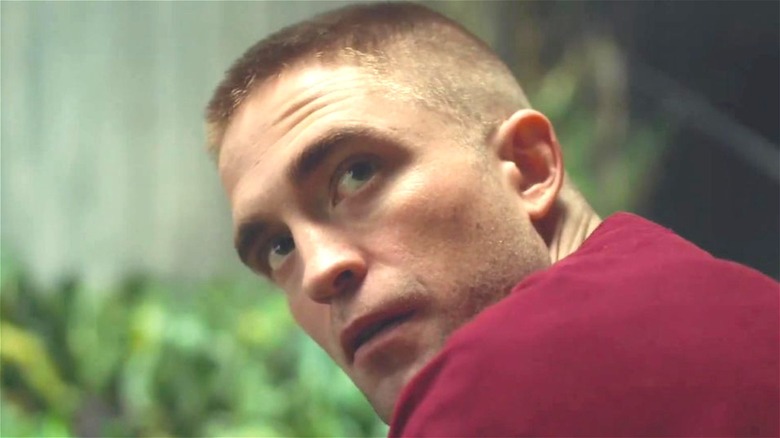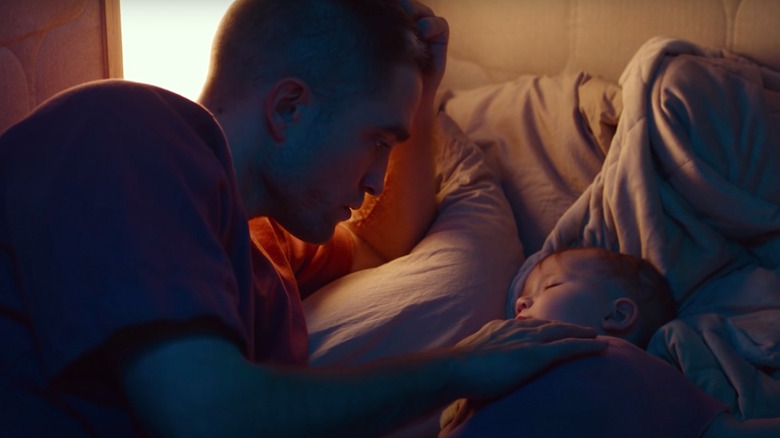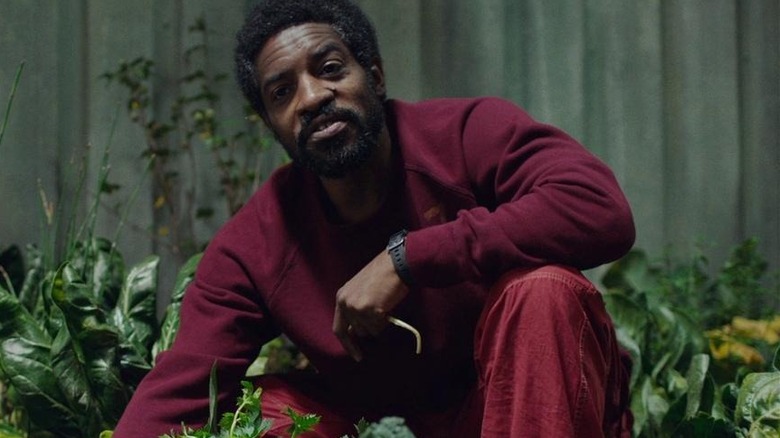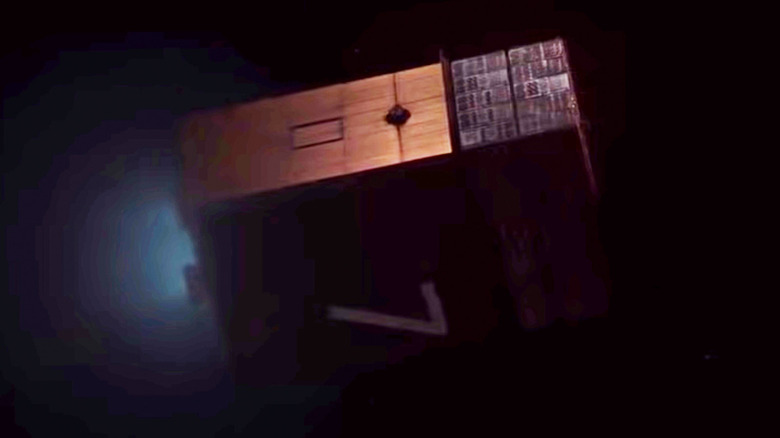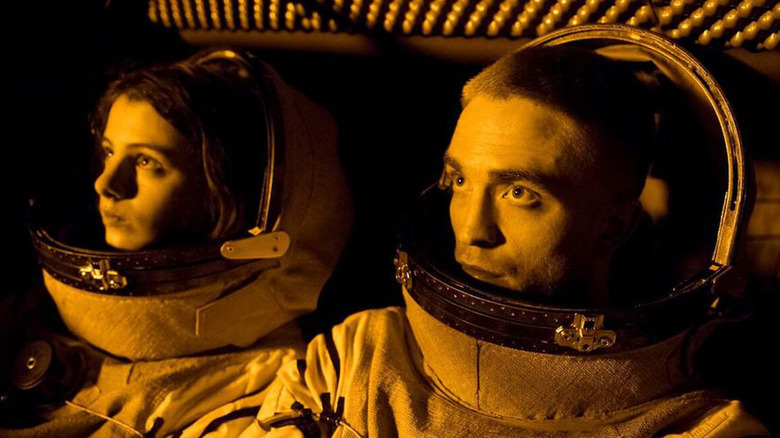The Ending Of High Life Explained
"High Life" is the 2018 sci-fi/horror psychological thriller that stars Robert Pattinson, André Benjamin, and Juliette Binoche as three crew members on an ethically dubious mission beyond the universe. If you like your sci-fi to be less "Alien" and "Star Wars" and more "Solaris" and "2001: A Space Odyssey," it should be right up your alley. Like those latter two films, "High Life" isn't exactly forthcoming about what it's up to, so chances are you might need a little help understanding the ending. That's where we come in.
Told in non-chronological order, "High Life" opens on a space ship whose crew is dead except for two passengers: Monte (Pattinson) and his baby daughter, Willow (Scarlette Lindsey). Then the movie shifts to show us how they got into this situation. Besides the captain Chandra (Lars Eidinger) and the medical officer Dr. Dibs (Binoche), the crew is made up entirely of prisoners from Earth. The mission's organizer (Victor Banerjee) offered them positions on the crew as a way to escape, but it's clear that joining the mission is just another form of imprisonment. Ostensibly, the purpose of the mission is to study the effects of deep-space radiation and black holes on human astronauts. But the sadistic Dr. Dibs begins performing her own experiments on the crew, attempting to conceive babies in space. Things spiral out of control and the crew members begin killing each other, but Dibs' project ultimately does show results when Boyse (Mia Goth) gives birth to Willow–even though everything about her conception is heinous.
"High Life" is about people trying to find hope in a hopeless situation. Ultimately there's no way for Monte and teenaged Willow (Jessie Ross) to escape their fates with their lives, but it's still a somewhat hopeful ending for two characters living in a bleak world.
When Monte becomes a father, he tries to make the best of an awful situation
In an interview with No Film School, Pattinson and director Claire Denis spoke about the film and its themes. The ship's crew members are all former prisoners who were sold on the idea of escaping Earth in order to serve science, but the ship is really just another prison. "The people controlling everything have no obligation to tell you the rules or anything, so you're living in this environment where everything can change on the dime," Pattinson said. "People can just experiment on you. You try and rebel against things, but you don't really know what's coming at any point and you have no autonomy."
Pattinson's character, Monte, tries to rebel against Dr. Dibs' experiments by refusing to participate. He's the only crew member who stays celibate and avoids the masturbatory "Black Box," which Dibs uses to harvest the crew's genetic material and attempts to impregnate the crew's female members. But like Pattinson said in the interview, rebellion is futile. Dibs simply drugs him, sexually assaults him, and uses his semen to conceive Willow.
Shortly after Willow is born, Dibs dies by suicide, leaving Monte and Willow as the only two survivors on a ship that can't return to Earth. It's an impossible environment in which to raise a child, especially one that was conceived without anyone's consent. And yet, when we first meet Monte, that's exactly what he's doing. Willow is the closest thing Monte has to hope in his situation.
The other characters' fates mirror Monte and Willow's
After we meet Monte and baby Willow, the movie details the fates of the other crew members. All of them die in different ways related to their doomed mission. Chandra develops leukemia from radiation and Dibs euthanizes him. Elektra (Gloria Obianyo) gives birth to a stillborn baby and later dies from complications. Mink (Claire Tran) stabs Ettore (Ewan Mitchell) to death after he attempted to sexually assault her and Boyse. An enraged Mink then tries to kill Dibs, but Monte is forced to kill her first. Later, a guilt-stricken and hopeless Dibs throws herself out of the airlock and into space.
But there are two deaths that foreshadow Monte and Willow's final moment: Boyse's and Tcherny's (Benjamin). The terminally ill pilot Nansen (Agata Buzek) was selected for the mission so that she could fly a smaller shuttle into a black hole and allow the crew to observe the results. But before she can do that, Boyse murders her with a shovel and takes her place. Rather than remain on the doomed vessel, Boyse chooses to escape into the unknown.
Shortly after Boyse's death, Tcherny decides to end his life in the ship's verdant garden. Earlier, he says that the garden is the only place that reminds him of home and Earth, and the wife and child he left behind. While Tcherny can't end his life surrounded by his loved ones, this is the closest alternative he can get.
In the end, Monte and Willow's decision is a combination of Boyse and Tcherny's choices.
What's up with the ship full of dogs?
Toward the end of "High Life," Monte and Willow realize that they're not the first crew sent on a doomed mission into deep space. Their ship locates another identical one. When Monte boards it, he discovers that it's entirely populated by stray dogs, which have all eaten each other to survive. Just like Monte and Willow, the few remaining dogs are the victims of a twisted experiment, and Monte's discovery has obvious implications for where he and Willow will end up — earlier in the movie, Monte was forced to shut down most of the ship's non-essential systems to conserve power. If things continue as they are, Monte and Willow will meet a similar fate as the dogs.
Willow asks her father to bring one of the dogs back onto their ship for companionship, but Monte fears that this would contaminate them. While it's possible that a stray dog might literally infect Monte and Willow, Monte is really worried that if his daughter learns the truth about the first ship, it will make her lose whatever hope she has for the future. He withholds the truth as a way to protect her.
But the discovery of the dog ship is a turning point for Monte as a character. He understands that no amount of hope is going to save him and his daughter. This sets the stage for their final choice.
Why do Monte and Willow fly through the black hole?
As Monte and Willow get closer to the black hole, Willow suggests that they pilot the ship's remaining shuttle into it. Monte agrees. It's a hopeful moment for both of them, for very different reasons.
Despite her conception, Willow is the only character who's innocent in this story. She didn't witness any of the brutality that led to her conception, and she didn't see Boyse fly into the black hole to become spaghettified. For her, flying through a black hole isn't necessarily a death sentence. It's a journey into an unknown world.
Monte knows better. He's seen what happened to Boyse. But he also understands that he and Willow don't have any good options. Yet he also doesn't tell her about what the black hole will do to them. For Monte, it's preferable to allow his daughter to believe in something good. As they fly into the black hole, Monte takes Willow's hand and savors his final moments with the only person he loves — it's the ending Tcherny wanted but couldn't have.
"High Life" ends without showing Monte and Willow being stretched into spaghetti. That leaves open the possibility that they don't "die" in the traditional sense. Flying into a black hole only looks like spaghettification to an outside observer, and Monte and Willow (and Boyse) might well still exist in some form in some kind of alternate reality. It might not be likely, but it's about as hopeful an ending as you can get in a movie as bleak and disturbing as this.
If you or anyone you know has been a victim of sexual assault, help is available. Visit the Rape, Abuse & Incest National Network website or contact RAINN's National Helpline at 1-800-656-HOPE (4673).
